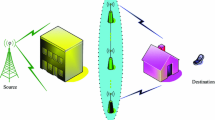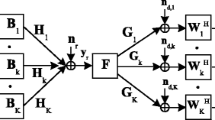Abstract
Relay beamforming techniques have been shown to significantly enhance the sum capacity of a multiuser cooperative wireless network through the optimization of the relay weights, where concurrent communications of multiple source-destination pairs are achieved via spatial multiplexing. Further optimization of the transmit power allocation over the source nodes is expected to improve the network throughput as well. In this paper, we maximize the sum capacity of a multiuser cooperative wireless network through the joint optimization of power allocation among source nodes and relay beamforming weights across the relay nodes. We consider a two-hop cooperative wireless network, consisting of single-antenna nodes, in which multiple concurrent links are relayed by a number of cooperative nodes. When a large number of relay nodes are available, the channels of different source-destination pairs can be orthogonalized, yielding enhanced sum network capacity. Such cooperative advantage is particularly significant in high signal-to-noise ratio (SNR) regime, in which the capacity follows a logarithm law with the SNR, whereas exploiting spatial multiplexing of multiple links yields capacity increment linear to the number of users. However, the capacity performance is compromised when the input SNR is low and/or when the number of relay nodes is limited. Joint optimization of source power allocation and relay beamforming is important when the input SNR and/or the number of relay nodes are moderate or the wireless channels experience different channel variances. In these cases, joint optimization of source power and distributed beamforming weights achieves significant capacity increment over both source selection and equal source power spatial multiplexing schemes. With consideration of the needs to deliver data from each source node, we further examine the optimization of global sum capacity in the presence of individual capacity requirements by maximizing sum capacity of the network subject to a minimum capacity constraint over each individual user.














Similar content being viewed by others
References
Zhang Y, Li X, Amin MG (2009) Distributed beamforming in multi-user cooperative wireless networks. In: Proc ChinaCom. Xi’an, China
Li X, Zhang Y, Amin MG (2009) Joint source power scheduling and distributed relay beamforming in multiuser cooperative wireless networks. In: Proc IEEE global communi conf, Honolulu, HI
Laneman JN, Wornell GW (2003) Distributed space-time coded protocols for exploiting cooperative diversity in wireless networks. IEEE Trans Inform Theory 49(10):2415–2425
Sendonaris A, Erkip E, Aazhang B (2003) User cooperative diversity—Part I and Part II. IEEE Trans Commun 51(11):1927–1948
Ochiai H, Mitran P, Poor H, Tarokh V (2005) Collaborative beamforming for distributed wireless ad hoc sensor networks. IEEE Trans Signal Process 53(11):4110–4124
Mudumbai R, Barriac G, Madhow U (2007) On the feasibility of distributed beamforming in wireless networks. IEEE Trans Wireless Commun 6(5):1754–1763
Havary-Nassab V, Shahbazpanahi S, Grami A, Luo ZQ (2008) Distributed beamforming for relay networks based on second-order statistics of the channel state information. IEEE Trans Signal Process 56(9):4306–4316
Zhao Y, Adve R, Lim TJ (2008) Beamforming with limited feedback in amplify-and-forward cooperative networks. IEEE Trans Wireless Commun 7(12):5145–5149
Chen H, Gershman AB, Shahbazpanahi S (2009) Distributed peer-to-peer beamforming for multiuser relay networks. In: Proc IEEE ICASSP, Taipei, Taiwan, pp 2265–2268
Nguyen D, Nguyen H (2009) Power allocation and distributed beam-forming optimization in relay-assisted multiuser communications. In: Proc int wireless commun and mobile comp conf. Leipzig, Germany
Bölcskei H, Nabar RU (2004) Realizing MIMO gains without user cooperation in large single-antenna wireless networks. In: Proc int symp inform theory, p 18
Bölcskei H, Nabar RU, Oyman Ö, Paulraj AJ (2006) Capacity scaling laws in MIMO relay networks. IEEE Trans Wireless Commun 5(6):1433–1444
Berger S, Wittneben A (2005) Cooperative distributed multiuser MMSE relaying in wireless ad-hoc networks. In: Proc Asilomar conf signals, systems and computers, pp 1072–1076
Abe T, Shi H, Asai T, Yoshino H (2006) Relay techniques for MIMO wireless networks with multiple source and destination pairs. EURASIP J Wirelss Commun Networking 2006(2):1–9
Oyman Ö, Paulraj AJ (2007) Power-bandwidth tradeoff in dense multi-antenna relay networks. IEEE Trans Wireless Commun 6(6):2282–2293
Viswanath P, Tse D, Laroia R (2002) Opportunistic beamforming using dumb antennas. IEEE Trans Inform Theory 48(6):1277–1294
Tse D, Viswanath P (2005) Fundamentals of wireless communications. Cambridge Univ. Press
Van Trees HL (2002) Optimum array processing. Wiley, New York
The mathworks optimization toolbox. Available at: http://www.mathworks.com/products/optimization. Accessed 10 June 2010
Ye Y SOLNP users’ guide—a nonlinear optimization program in MATLAB. Available at: http://www.stanford.edu/~yyye/matlab/manual.ps. Accessed 10 June 2010
Rong Y, Hua Y, Swami A, Swindlehurst AL (2008) Space-time power schedule for distributed MIMO links without instantaneous channel state information at the transmitting nodes. IEEE Trans Signal Process 56(2):686–701
Rong Y, Hua Y, (2008) Optimal power schedule for distributed MIMO links. IEEE Trans Wireless Commun 7(8):2896–2900
Author information
Authors and Affiliations
Corresponding author
Additional information
Part of this work was presented in 2009 International Conference on Communications and Networking in China (ChinaCom’09) [1] and 2009 IEEE Global Communications Conference (Globecom’09) [2].
This work was supported in part by DARPA under contract no. HR0011-07-1-0001. The content of the information does not necessarily reflect the position or the policy of the Government, and no official endorsement should be inferred. Approved for Public Release, Distribution Unlimited.
Rights and permissions
About this article
Cite this article
Li, X., Zhang, Y.D. & Amin, M.G. Joint Optimization of Source Power Allocation and Relay Beamforming in Multiuser Cooperative Wireless Networks. Mobile Netw Appl 16, 562–575 (2011). https://doi.org/10.1007/s11036-010-0245-7
Published:
Issue Date:
DOI: https://doi.org/10.1007/s11036-010-0245-7




